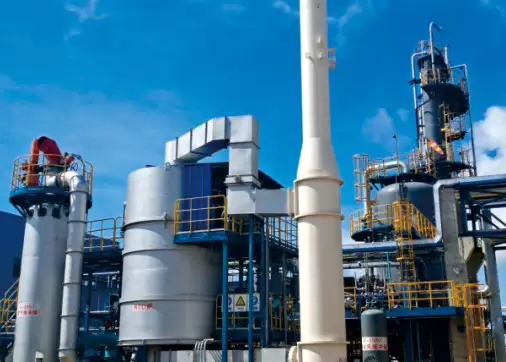Regenerative Thermal Oxidizer in pulp and paper industry
Introduction
In the pulp and paper industry, there is an increasing demand for eco-friendly solutions that reduce pollution and greenhouse gas emissions. Regenerative Thermal Oxidizer (RTO) is one of the most effective solutions for this industry. RTO is a technology that uses high-temperature combustion to treat harmful air pollutants. It is widely used in the pulp and paper industry to reduce air pollution and promote environmental sustainability.
Working Principle of Regenerative Thermal Oxidizer
A Regenerative Thermal Oxidizer is a complex system that involves a series of processes. The working principle of RTO is based on the principle of combustion. The RTO system consists of a combustion chamber, a heat exchanger, and a control system. The process starts with the emission of harmful pollutants from the pulp and paper industry. The polluted air is then directed into the combustion chamber, where it is heated to a high temperature. At high temperatures, the pollutants oxidize, producing harmless products such as water and carbon dioxide. The heat generated during the combustion is then transferred to the heat exchanger, where it is used to preheat the incoming polluted air before entering the combustion chamber. This process helps to minimize the energy required to run the RTO system.
Advantages of Using Regenerative Thermal Oxidizer
Using RTO in the pulp and paper industry has several advantages, including:
- RTO is an effective solution for reducing air pollution in the pulp and paper industry.
- It helps to promote environmental sustainability by reducing greenhouse gas emissions.
- RTO systems are energy-efficient and require minimal maintenance.
- The system is easy to operate and can be integrated into the existing process systems without major modifications.
- RTO is a cost-effective solution for reducing air pollution in the pulp and paper industry.
Applications of Regenerative Thermal Oxidizer in Pulp and Paper Industry
Regenerative Thermal Oxidizer is widely used in the pulp and paper industry for various applications, including:
Volatile organic compounds (VOCs) control
Volatile organic compounds are one of the major pollutants released during the pulp and paper manufacturing process. RTO is an effective solution for controlling VOCs emissions. The system is designed to operate at high temperatures, which helps to oxidize the VOCs to harmless products.
Odor control
Odor control is another application of RTO systems in the pulp and paper industry. RTO systems are designed to remove unpleasant odors from the air by oxidizing the odor-causing compounds.
Solid waste incineration
RTO systems are also used in the pulp and paper industry for solid waste incineration. The system is designed to combust the solid waste, reducing it to ash and reducing the volume of the waste.
Conclusion
Regenerative Thermal Oxidizer is an effective solution for reducing air pollution in the pulp and paper industry. The system is designed to operate at high temperatures, which helps to oxidize the pollutants to harmless products. RTO systems are energy-efficient, cost-effective, and easy to operate. Using RTO in the pulp and paper industry helps to promote environmental sustainability by reducing greenhouse gas emissions. It is a versatile system that can be used for various applications, including VOCs control, odor control, and solid waste incineration. By adopting eco-friendly solutions like RTO, the pulp and paper industry can minimize its impact on the environment and promote sustainability.
Company Introduction
We are a high-end equipment manufacturing enterprise specializing in the comprehensive treatment of volatile organic compounds (VOCs) exhaust gas and carbon reduction energy-saving technology in the pulp and paper industry.
Core Technologies
- Thermal energy, combustion, sealing, and automatic control
- Temperature field simulation and airflow field simulation modeling
- Performance testing of ceramic regenerative materials, selection of zeolite molecular sieve adsorbents, and high-temperature incineration and oxidation of VOCs
Team Advantages
We have established an RTO technology research and development center and a waste gas carbon reduction engineering technical center in Xi’an, as well as a 30,000 square meter production base in Yangling. We are a leading manufacturer of RTO equipment and zeolite molecular sieve rotary equipment worldwide. Our core technical team comes from the Aerospace Liquid Rocket Engine Research Institute (Aerospace Sixth Institute). We currently have more than 360 employees, including over 60 research and development technology backbones. Among them, there are three senior engineers at the researcher level, six senior engineers, and 40 thermodynamics doctors.
Core Products
Our core products include the rotary valve regenerative thermal oxidizer (RTO) and zeolite molecular sieve adsorption and concentration rotary equipment. With our expertise in environmental protection and thermal energy system engineering, we can provide customers with comprehensive solutions for industrial exhaust gas treatment, carbon reduction, and thermal energy utilization under various operating conditions.

Certifications, Patents, and Honors
- Intellectual Property Management System Certification
- Quality Management System Certification
- Environmental Management System Certification
- Construction Industry Enterprise Qualification
- High-tech Enterprise
- Patent for Rotary Valve Regenerative Thermal Oxidizer
- Patent for Rotary Heat Storage Incineration Equipment
- Patent for Disc Zeolite Rotary Equipment

Choosing the Right RTO Equipment
- Identify the specific requirements of the industrial process and exhaust gas treatment.
- Consider the volume and composition of the exhaust gas to determine the capacity and material selection of the RTO equipment.
- Analyze the available space and site conditions to design the appropriate layout and configuration of the RTO system.
- Evaluate the energy efficiency and operating costs to select an RTO equipment that meets the desired performance and budget requirements.
Service Process
- Consultation and Assessment:
- Preliminary consultation
- Site inspection
- Needs analysis
- Design and Plan:
- Solution design
- Simulation and modeling
- Solution review
- Production and Manufacturing:
- Customized production
- Quality control
- Factory testing
- Installation and Commissioning:
- On-site installation
- Commissioning and operation
- Training services
- After-sales Support:
- Regular maintenance
- Technical support
- Spare parts supply
Author: Miya
